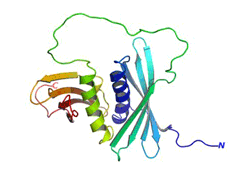
| Serial No. | GA-P0019HU |
| Species | Human |
| Specification | 0.1 mg/0.2mg |
| Brand | GenAsia |
| Origin | Shanghai |
| Price | US$350/US$620 |
Detailed information
1 Host: Escherichia coli (E. coli)
2 Species: Human
3 Protein Type: Recombinant
4 Synonyms: IL17, CTLA8, IL-17, IL-17A, Ctla-8, Ctla8, Il17, ChIL-17, IL-17F, IL17A, CTLA-8
5 Purity: 95% by SDS-PAGE
6 Application: WB、 Elisa、 Functional Studies
7 Background:
The original described IL-17 protein, now known as IL-17A, was identified from a CD4+ T cells DNA library. IL-17 can be induced from primary peripheral blood CD4+ T cells upon stimulation. Supernatant from cells transfected with IL-17 induced IL-16 and IL-18 production and enhanced the surface expression of the intraCellular adhesion molecule-1 (ICAM-1) in human fibroblasts. Recombinant IL-17 is a 31 kDa disulfide-linked homodier of two 136 amino acid polypeptide chains.
8 Storage&Stability:
Avoid repeated freeze and thaw cycle.Store at 2-8℃ for delivery and store at -20 or -70℃ for future use. The loss rate of the target protein which describes the stability was determined by accelerated thermal degradation test.That is to incubate the protein at 37℃ for 48h and no obvious degradation and precipitation were observed.The loss of this protein is less than 5% within the expiration date under appropriate storage condition.
2 Species: Human
3 Protein Type: Recombinant
4 Synonyms: IL17, CTLA8, IL-17, IL-17A, Ctla-8, Ctla8, Il17, ChIL-17, IL-17F, IL17A, CTLA-8
5 Purity: 95% by SDS-PAGE
6 Application: WB、 Elisa、 Functional Studies
7 Background:
The original described IL-17 protein, now known as IL-17A, was identified from a CD4+ T cells DNA library. IL-17 can be induced from primary peripheral blood CD4+ T cells upon stimulation. Supernatant from cells transfected with IL-17 induced IL-16 and IL-18 production and enhanced the surface expression of the intraCellular adhesion molecule-1 (ICAM-1) in human fibroblasts. Recombinant IL-17 is a 31 kDa disulfide-linked homodier of two 136 amino acid polypeptide chains.
8 Storage&Stability:
Avoid repeated freeze and thaw cycle.Store at 2-8℃ for delivery and store at -20 or -70℃ for future use. The loss rate of the target protein which describes the stability was determined by accelerated thermal degradation test.That is to incubate the protein at 37℃ for 48h and no obvious degradation and precipitation were observed.The loss of this protein is less than 5% within the expiration date under appropriate storage condition.








